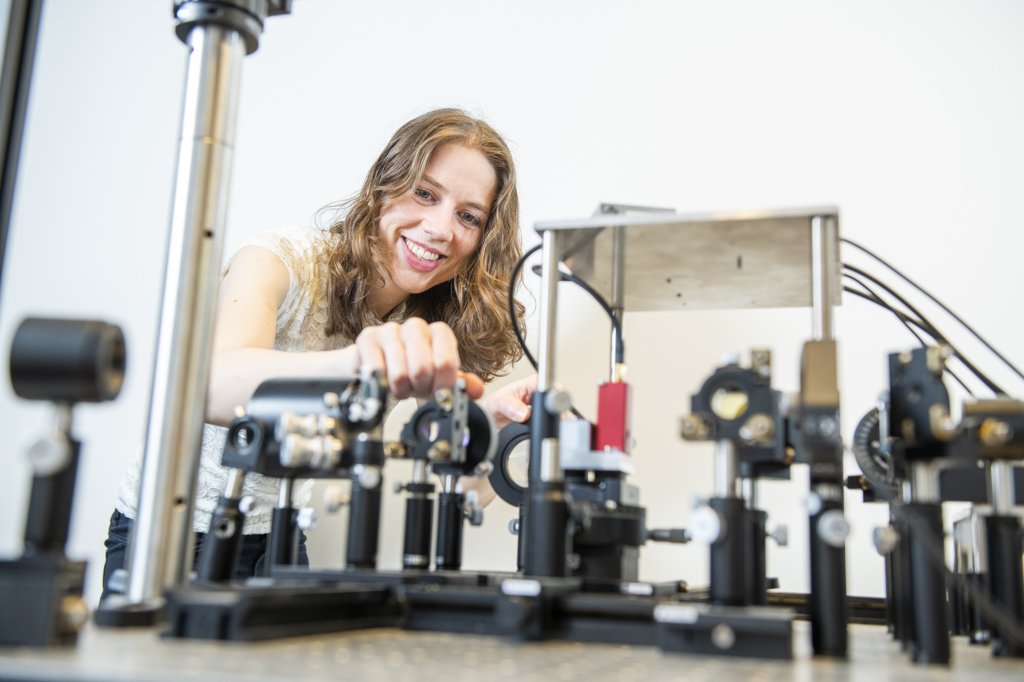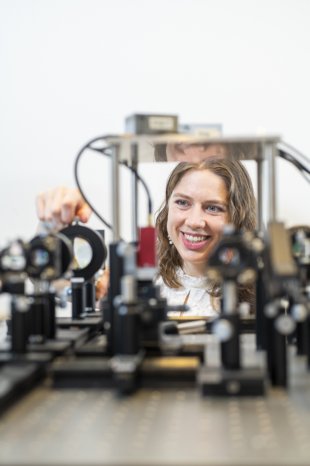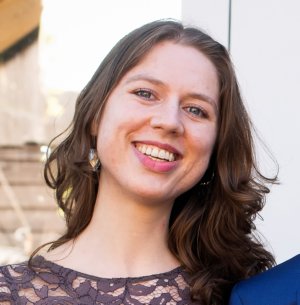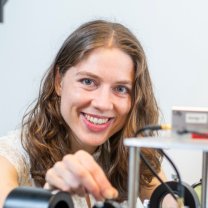"If we don't do something now, it will stay this way for another 100 years"
September 2020
The number of people allowed to attend her PhD defence at Wageningen University & Research depends on the ever-changing corona guidelines, but it is clear that there will not be enough places for all the people she thanks passionately in her thesis. They can then watch via a live stream. With her successful materials research, including two articles in top journals Nature Communications and Advanced Materials, future Doctor Hanne van der Kooij wants to show that people with disabilities can also be successful in science.
Text and interview: Diederik Rep
Photos: Leonie Voets
(A Dutch version of this interview is available here.)
No stopping
As a PhD candidate with Prof. Joris Sprakel and Prof. Jasper van der Gucht in the Physical Chemistry and Soft Matter group, Van der Kooij (1989) worked on a project of the Dutch Polymer Institute, co-financed by companies from the paint industry. The challenge: to gain better insight into the drying process of water-based paint. Key to that behaviour is the collective dynamics of the molecules, which move in all kinds of ways and influence each other as the paint dries and changes. “Thanks to advanced microscopy techniques, we know a lot about the individual building blocks, for example how two paint particles influence each other. But what happens when you have a collective of countless molecules, as in drying paint? It is precisely the collaboration between large numbers of molecules that determines the macroscopically visible behaviour of material systems.” A fast technique looking deep into drying paints without disrupting the drying process did not yet exist, until the Wageningen team started working with Laser Speckle Imaging (LSI), a technique from the medical field. “When it turned out that LSI has so much more potential than just studying paint, there was just no stopping,” says Van der Kooij. Her dissertation reads as a love letter to the technology.
Scattering
Many types of paint are non-transparent, so that optical microscopy methods cannot be used: the light from the microscope is scattered too much by the particles contained in the paint. The team in Wageningen decided to aim a laser at the paint and make a virtue of that scattering. LSI lets a laser beam scatter on a material with the scattered light rays interfering with each other; a fast camera then registers a noise-like scattering and interference pattern. This noise pattern itself is difficult to decipher, but LSI comes into its own as soon as one of the scattering particles moves. Even the smallest displacement, down to 1 nanometre (or 1 trillionth metre, the scale of a few atoms), causes measurably large changes in the noise pattern. The special achievement of Van der Kooij and the team in Wageningen is that they have converted this principle into a versatile materials science measurement technique that yields quantitative results.

From four to five dimensions
“We put together everything that was known about the technology. What we now extract from the raw data is unique, it has never been done before. The precursor to LSI was used without spatial resolution; it looked at 1 pixel. We have extended the calculation methods for 1 pixel to a grid of pixels. The result is a camera-based, quantitative analysis method that generates spatially resolved images. That is what makes LSI so powerful. We have also added our own touch: spectral resolution. This means that we can map all dynamic processes - from rapidly vibrating molecules to slow deformations on a macro-scale - in one fell swoop.” LSI thus works in four dimensions: two spatial dimensions, the time dimension and the spectral dimension. “My fellow PhD candidate is now working on adding another spatial dimension so that we can also adjust how deep we look into a material. That is not yet possible; we average over all depths reached by the laser. Depth sensitivity is a holy grail for LSI.”
Side projects
Professors Sybrand van der Zwaag (TU Delft) and Dirk Broer (TU Eindhoven) heard Van der Kooij present her LSI results. They were immediately enthusiastic and approached her to apply the new technique to their own material systems: self-healing elastomers in Delft and electrically controlled liquid crystals in Eindhoven. The ‘side projects’ that evolved in this way yielded the most striking results of her promotion. “It felt a bit awkward that I couldn’t spend as much time on the paints as a result. I hope the paint manufacturers got their money's worth after all. Thanks to the collaboration with Eindhoven and Delft, LSI has been lifted to greater heights than would have been possible if we had limited ourselves to paint. A version of our LSI equipment is now being used by a paint manufacturer in their own investigation of the drying process. For only 160 euros in parts, my colleague has also developed a portable LSI, which is currently applied to the restoration of paintings in the Rijksmuseum, hopefully even to The Night Watch. My fascination for paint will always remain.”
Exemplary scientists
Van der Kooij is lyrical about the collaborations that arose during her PhD. “Together we can do so much more than alone. Through conversations with others, whether students or professors, I have learned so many new things.” What is the recipe for a successful collaboration according to Van der Kooij? "Look for complementary expertise, come up with a specific question and keep the communication going." Platforms such as the Dutch Polymer Institute and the federation of Dutch universities of technologies, 4TU, can contribute to this. “The success factor in our collaboration with Eindhoven and Delft is that we were on the same wavelength; we all had the desire to let the collaboration flourish.” She calls Broer and Van der Zwaag exemplary scientists: "They show that you can be an excellent scientist - because they are - and also a team player."
Dream job
After the formal conclusion of her doctoral research, Van der Kooij will continue in the group where she worked for the past years. “My promotion was mainly dedicated to building my own CV. In my new position I am there for others. As a jack of all trades I can take over responsibilities and tasks from other staff members where necessary. So, I don't have to start my own group and fight myself up, but I can help others in their fight.” This new position as ‘staff scientist’ was created especially for her. “It's my dream job,” says Van der Kooij. “I generalize, but women are naturally more focused on social cohesion. Men tend to pretend to be tougher than they really are. They are by nature better car salesmen. And that is necessary in order to work your way up to a professorship. That fight doesn't suit me. I am happiest when I’m supporting other people.” The new position may pay for itself in the long term. “There are plenty of grant programmes that focus on collaborations, where proposals are submitted by a main applicant and a co-applicant. I would love to be that co-applicant.”
Proactive measures
Van der Kooij does not deny that the fact that she is a young woman could help in securing research funding. Although the contribution of women to Dutch science has increased in recent years, there are few countries in the world with so few female scientists. “For years I thought that this problem would resolve itself, and that women just had to stand up for themselves a little bit more. But progress is too slow; there is still a shortage of young women. The ratio is good among PhD students and postdocs, but then things go wrong. I have a lot of admiration for the women who do go further, because you have to work hard, be super smart and be lucky. Few women feel like fighting their male competitors or macho behaviour.” Van der Kooij argues for proactive measures, such as those recently taken by Eindhoven University of Technology, where vacancies were initially opened to women only and later to men as well. “You really need role models. If there are not enough visible women at the top, then the ratios are levelled too slowly.”
Functional limitations
“But it is about more than the male/female ratio. It also concerns people with a different skin colour, a different sexuality, or with a disability, such as me. In science you mainly see heterosexual white men who work full-time. That slipped in unconsciously and does not change just like that, not spontaneously. If we don't do something now, it will stay this way for another 100 years. I have no ambition at all to be known as such, but I do want to be open about my own disabilities, to inspire people in a similar position. My mental health is not as good as that of others. I have a nice cocktail of small ‘backpacks’. I need more time for myself, to deal with things, to process impressions. Because of its unpredictability, science is chaotic for someone with disabilities on the autism spectrum. That's why I can't work full-time. At the same time, my brain makes connections faster, I see all kinds of details. That is also a strength.”
Taboo
It is taboo in society as a whole, not just in science, Van der Kooij observes. “Here in Wageningen I can be open about it, but that’s not the case everywhere. I know enough people with disabilities, such as ADHD, autism or depression, who won’t tell the company doctor. They do not want that stamp, because it can damage their career opportunities. I get it: nobody wants a sick employee, I would also rather be completely healthy. If you can't work because of a broken leg, everyone will understand. But someone who cancels last minute because he is at home depressed? There is not enough room to talk about that. And then it appears as if it doesn’t occur that often. But everyone has something, right? I think these kinds of mental limitations often go hand in hand with unique mental powers. I really don't want to compare myself to a genius, but look at Einstein and Tesla. The greatest geniuses have the greatest mental limitations. I notice, for example, that certain types of autism are more common in intellectual groups.”
Rat race
 It is a vulnerable subject, says Van der Kooij. Perhaps that is why change cannot be forced. “You have to be very strong, mentally and physically, in order to survive in science. If you can’t or don’t want to, then you will drop out. I would have dropped out if Joris [Sprakel] and Jasper [van der Gucht] had not offered me this unique opportunity. My group knows my limitations and takes them into account wonderfully. The freedom and understanding are exceptional here. I sometimes think: I'm really not going to find this anywhere else. Despite my disabilities, I can play a nice role in academia, I am valuable, even if I don’t work full-time. If you work less than full time, you also have more time to be creative, to let results sink in. You are less stuck in the rat race, you can take more distance. Quality over quantity. I see that my colleagues who work 80% are doing a fantastic job, you don't notice it from their CV.”
It is a vulnerable subject, says Van der Kooij. Perhaps that is why change cannot be forced. “You have to be very strong, mentally and physically, in order to survive in science. If you can’t or don’t want to, then you will drop out. I would have dropped out if Joris [Sprakel] and Jasper [van der Gucht] had not offered me this unique opportunity. My group knows my limitations and takes them into account wonderfully. The freedom and understanding are exceptional here. I sometimes think: I'm really not going to find this anywhere else. Despite my disabilities, I can play a nice role in academia, I am valuable, even if I don’t work full-time. If you work less than full time, you also have more time to be creative, to let results sink in. You are less stuck in the rat race, you can take more distance. Quality over quantity. I see that my colleagues who work 80% are doing a fantastic job, you don't notice it from their CV.”
You are not alone
What does Van der Kooij advise people with similar disabilities? “Be honest about it - your employer has a right to know and it’s also so much more pleasant if they understand your situation. You don't have to shout it from the rooftops, but when people ask, be honest about it. It’s very scary to talk about, but there’s more understanding than you think. Ultimately, most people know people with similar problems. There is so much physical and mental suffering on this earth; it’s much more common than you think. Don't be afraid to express yourself - you are not alone. And if you run into misunderstanding, go somewhere else, because you may not want to work for such an employer. It's important to feel safe, to be yourself, to be honest. Of course, it’s a job, so putting your best foot forward and sometimes putting your own problems aside is part of the deal. But you really come into your own in an environment where you are appreciated, respected and understood. I have experienced that myself.”
Less indispensable
Back to the upcoming promotion and the LSI technique. How does Van der Kooij envision the future of ‘her’ technology? "My dream for the future is to apply the technique to many more remarkable materials, and to gain more insight into the collective movements that evolve from very small length and time scales into macroscopic material changes." She calls it the dance of the molecules. Will there soon be an LSI in every materials laboratory? “I hope that even our smartphones will soon contain LSI technology! But I fear that we ourselves don’t have enough affinity with the commercial exploitation of our LSI expertise. If you want to do it, please do not hesitate to contact us. We mostly want to do cool scientific research and give something back to society. In fact, I'd rather everyone start using LSI. In my new position, I don't just have to think about my own CV, I can make myself less indispensable. Just send it out into the world, I think that will eventually make us much happier.”

Dr. Hanne van der Kooij is a staff scientist at Wageningen University & Research in the Physical Chemistry and Soft Matter group of prof. Jasper van der Gucht.







